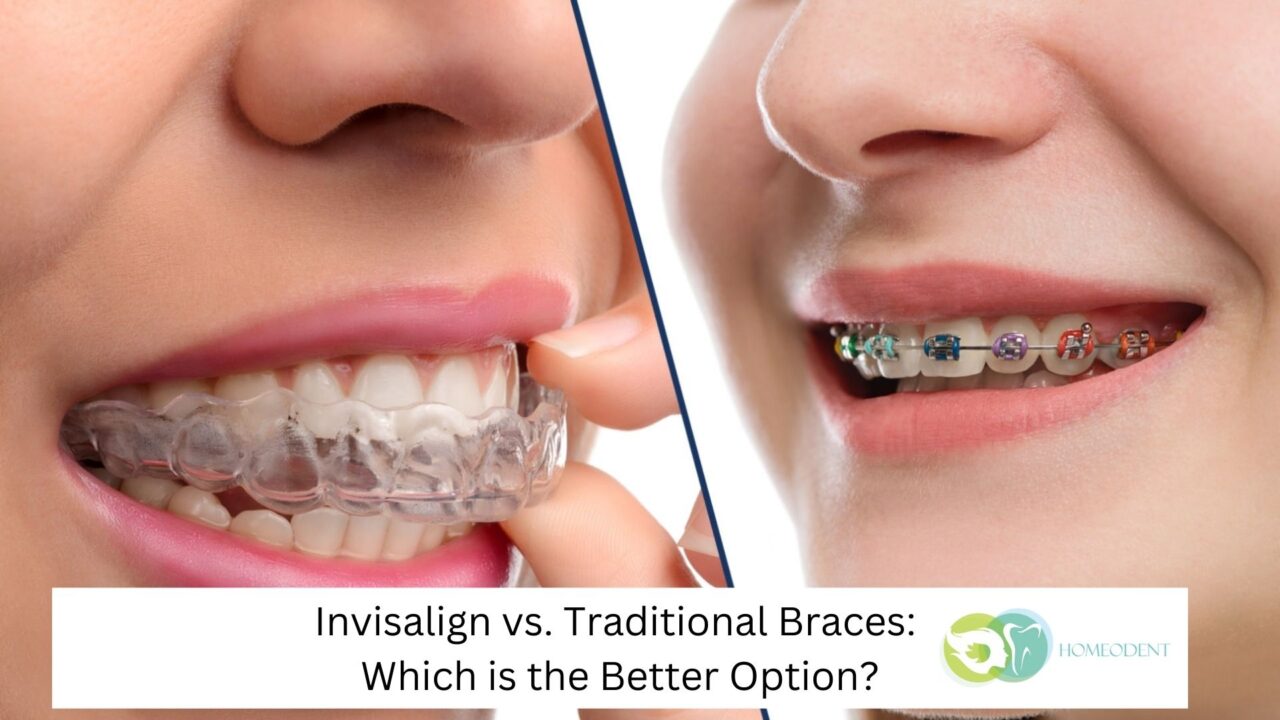Introduction:
Straight teeth raise your confidence while also improving your dental health. However, many people are anxious to get orthodontic treatment because they are concerned about the discomfort of traditional metal braces. There is, thankfully, an alternative: Invisalign. We’ll compare Invisalign vs. traditional braces in this article to assist you in figuring out which choice is best for you.
Invisalign vs. Traditional Braces: What’s the Difference?
Before we dive into the pros and cons of each option, let’s take a look at how Invisalign and traditional braces differ:
Invisalign: Invisalign uses transparent, silicone aligners that are custom-fit to your teeth. These aligners are adjustable, and you change them every two weeks to gently push your teeth into position. Invisalign treatment usually lasts 12 to 18 months.
Traditional Braces: Metal brackets and wires are connected to your teeth in traditional braces. The wires are adjusted regularly to relocate your teeth into position gently. Traditional braces treatment generally lasts 18-24 months.
Pros and Cons of Invisalign
Invisalign Advantages and disadvantages
Invisalign has grown in popularity in recent years, and for a good reason. Here are some of the advantages and disadvantages of Invisalign:
Pros:
Because Invisalign aligners are practically invisible, they are an excellent solution for people who do not want to draw attention to their orthodontic treatment.
Removable: Because Invisalign aligners are removable, you may eat and drink anything you want without fear of hurting your braces. You may also take your aligners out for special events or to clean and floss your teeth.
Comfortable: Invisalign aligners are more pleasant than regular braces’ metal brackets and wires since they are built of smooth plastic.
Fewer office visits: Because you switch to a new set of aligners every two weeks, you typically need to visit the orthodontist less frequently than traditional braces.
Cons:
Requires discipline: Invisalign aligners must be worn for at least 22 hours daily to be effective, which requires discipline and dedication.
Cost: Invisalign treatment is generally more expensive than traditional braces.
Limited effectiveness: Invisalign may not be suitable for severe orthodontic problems, such as significant gaps or rotated teeth.
Heading 3: Pros and Cons of Traditional Braces
For millennia, traditional braces were the go-to orthodontic procedure. Here are some of the benefits and drawbacks of regular braces:
Pros:
Effective: Traditional braces are effective for treating many orthodontic problems, from minor crowding to severe malocclusions.
Cost: Traditional braces are generally less expensive than Invisalign.
No discipline required: Traditional braces are fixed to your teeth, so you don’t need to worry about remembering to wear them or losing them.
Cons:
Visible: Traditional braces are apparent and can be a source of self-consciousness for some people.
Discomfort: The brackets and wires of traditional braces can be uncomfortable and may cause irritation or soreness.
Food restrictions: With traditional braces, you must avoid certain foods that can damage or get stuck in your braces.
Frequent office visits: With traditional braces, you must visit the orthodontist every four to six weeks for adjustments.
FAQs
The three most essential things to know about Invisalign are:
- Invisalign uses clear, custom-made aligners to straighten teeth.
- The aligners are made of durable, clear plastic that is virtually invisible.
- Invisalign treatment typically takes about 12 to 18 months.
What are traditional braces?
- Traditional braces consist of metal or ceramic brackets glued to your teeth and wires and elastics that apply pressure to move your teeth into place.
The three most important things to know about traditional braces are:
- Traditional braces consist of metal or ceramic brackets, wires, and elastics.
- Braces can be more noticeable and sometimes cause discomfort or irritation in the mouth.
- Treatment with traditional braces typically takes about 18 to 36 months.
The three most important benefits of Invisalign are:
- Invisalign aligners are virtually invisible, making them a more discreet option.
- Invisalign aligners are removable, making eating, brushing, and flossing easier.
- Invisalign aligners are often more comfortable than traditional braces because they don’t have brackets or wires that can irritate the mouth.

